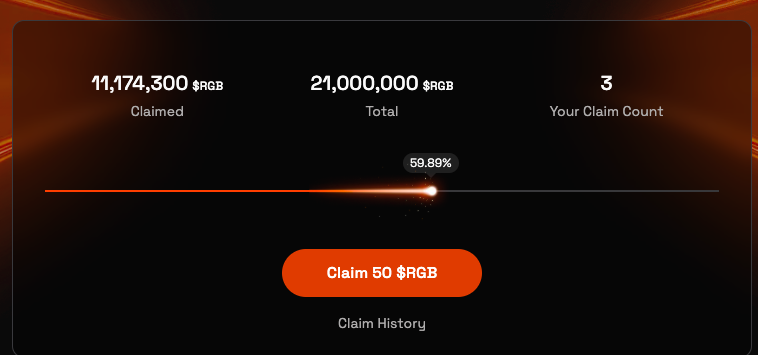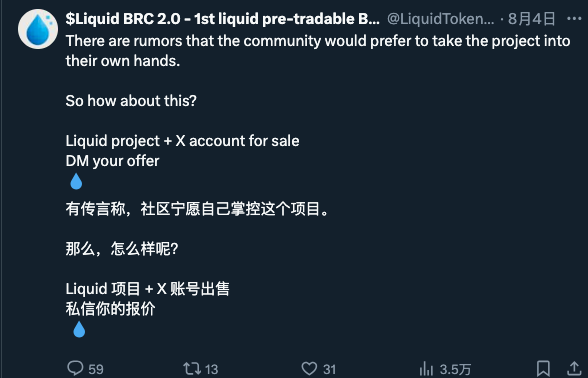X-trader NEWS
Open your markets potential
The Bitcoin ecosystem is back? Quickly view the progress of recent hot projects

Odaily Planet Daily
Author / Golem
Recently, the overall activity of the Bitcoin ecosystem has increased, and many long-developed projects have entered the delivery or new milestone stage, such as RGB, sat 20, BRC 2.0, etc. Odaily Planet Daily will briefly sort out the progress of related projects in this article for ecosystem players to explore the wealth code by themselves.
RGB Protocol: The first token on the mainnet will open for申领 again on August 14th
The RGB protocol was launched on the Bitcoin mainnet on August 7th, and simultaneously issued the first token RGB on the mainnet, with a total of 21 million tokens, adopting a fair application mode, but each application requires a fee of about $4.
According to community estimates, it would take about 24 hours to complete the RGB token application. However, in reality, as of now (after 5 days), the progress of RGB token application is 60%. The main reason may be that the event was too popular, with excessive website traffic and long application queues. Bitlight Labs has carried out server upgrades multiple times and suspended applications to upgrade defense measures to combat robots, etc.

According to the official announcement, Bitlight Labs has basically completed the defense measures against robot applications, and plans to release Bitlight Wallet v1.1.3 and reopen RGB token applications at 17:00 on August 14, 2025. However, only 10% of the tokens will be opened for application testing this time. If the test results are satisfactory, the remaining progress of RGB token applications will be reopened one after another.
Although the launch of the RGB protocol on the mainnet did not meet users' expectations and even suffered a lot of FUD, from the application process, Bitlight Labs is still continuously developing and improving, and actively cracking down on robot application behaviors, which to a certain extent maintains the fairness of the application and the dispersion of token chips, preventing a large number of chips from being concentrated in the hands of a few people, which is conducive to the later community development.
Even though there is no official trading market yet, the distributed RGB tokens can be directly transferred through the wallet. At present, the price of a single RGB (50 tokens) is between $10-13, which has achieved a 2-3 times return compared with the application cost. Therefore, after the application reopens on August 14th, the competition for applications may further increase. For more introductions and application tutorials of the RGB protocol, you can read Odaily's previous articles. (Related reading: After waiting for two years, is this what the RGB protocol looks like when it goes live on the mainnet?)
BRC 2.0 Upgrade: Phase 1 postponed to September 2nd
BRC 2.0 is an upgrade to the BRC 20 protocol launched by Best in Slot, aiming to enable EVM-compatible smart contract functions for all BRC 20 tokens. Best in Slot originally planned to carry out the first phase of BRC 2.0 upgrade on the mainnet at block height 909969 (around August 14th), enabling 6-character BRC 20 tokens and launching a launchpad. However, due to insufficient preparation, the upgrade was postponed to block height 912,690, around September 2nd.
Perhaps due to the postponement of the upgrade date, the market value of Pre-BRC 2.0 assets has also fallen overall. The first BRC 2.0 concept NFT Adderrels currently has a floor price of 0.0076 BTC (about $900), a 60% drop from the peak. However, the Adderrels project team is still operating, and has updated the details of staking NFTs to obtain token airdrops. The airdrops will be distributed in three seasons, releasing 8%, 9%, and 10% of the total supply respectively. The first quarter token airdrop will be distributed when BRC 2.0 goes online on September 2nd.
Another project, LIQUID, which claims to be the first Pre-BRC 2.0 token minted on Ordinals, has moved towards the community CTO. Previously, the original project team of LIQUID planned to sell the entire project, causing a wave of panic. Currently, the price of LIQUID is 0.00006 BTC, close to the minting cost.

For more introductions to the BRC 2.0 upgrade, you can read Odaily's previous articles. (Related reading: Mainnet countdown, BRC 2.0 upgrade ignites the BTC ecosystem, leading NFTs rise 100 times in a month | BTC Ecosystem)
SAT 20 Protocol: SatoshiNet mainnet goes live
The SAT 20 protocol is a BTC-native asset issuance and circulation protocol that has been under development for 2 years. Its core feature is that assets are bound to satoshis and flow freely with them. SatoshiNet is a Bitcoin-native Layer 2 built based on the SAT 20 protocol, based on Lightning Channels + parallel BTC network. Its purpose is to expand the liquidity of BTC mainnet native assets, supporting various protocol assets such as Ordinals, Runes, OrdX, BRC 20, etc. The SatoshiNet mainnet was officially launched on August 8, 2025.
The core of SatoshiNet lies in four contract capabilities: Asset Launch Contract (LaunchPool), Asset Transcend Contract (Transcend), AMM Trading Contract (Swap), and Limit Order Contract (LimitOrder). These capabilities enable SatoshiNet to have functions such as instant settlement, extremely low fees, and compatibility with Bitcoin assets.
Currently, SatoshiNet has deployed four transcend contracts, namely BTC, pearl, rarepizza (ordx asset), and DOG•GO•TO•THE•MOON (Runes asset). ordx is the native asset issuance of the SAT 20 protocol, which is an enhanced version of the Ordinals protocol. The issued assets are called satoshi assets (SAT 20 ASSETS), which are bound to satoshis and have the attributes of satoshis. Pearl is the first token of the ORDX protocol and also becomes the governance token of the SatoshiNet network.
The publicly disclosed team members of the SAT 20 protocol include huige, who is in charge of marketing operations and English-speaking business development, and Jiangangshan, the technical director. SATSWAP is currently the first DEX of SatoshiNet, with functions such as token launch, trading market, and limit orders.
Although the SAT 20 protocol has been under development for two years and has formed a solid community, it has not created enough wealth effect to attract more attention.
Bitcoin-native Layer 2 Spark: Launchpad启动
Spark claims to be a Bitcoin-native L2 designed specifically for payment and settlement, but does not support smart contracts and has its own token issuance standard LRC 20. On August 11th, one of the only two node operators of the Spark protocol, Spark browser sparkscan Flashnet, conducted LRC 20 AMM function testing on Spark. However, the test was not smooth, and it is estimated that it will take some time before the official launch of DEX.
At the same time, on August 1st, Luminex, a Bitcoin ecosystem token launch platform, announced a cooperation with Spark official to launch a Launchpad, which excited ecosystem players briefly, but it has not been launched yet. However, on August 11th, another LRC 20 Launchpad, utxo.fun, was launched simultaneously with the AMM test of Flashnet, but still encountered serious problems. The platform processed user refunds and temporarily prohibited token issuance.
But even so, the floor price of FSPKS (ending with b55e), the leading token of LRC 20, is still $100, which is a 50-fold return compared with the initial minting cost of $2. For more content about the Spark protocol, you can read Odaily's previous article (Related reading: Detailed explanation of Spark and its ecosystem: a16z support, new Bitcoin L2 founded with the help of PayPal)
BitVM 2 Bitcoin Bridge Fiamma: Mainnet goes live
Fiamma is a Bitcoin wealth management platform, with core products including Fiamma One, a non-custodial super app for earning BTC returns with one click, and Fiamma Bridge built based on BitVM 2. On August 6th, Fiamma was officially launched, allowing BTC to be transferred to 11 chains including Ethereum, Arbitrum, Aptos, BNB Chain, Base, etc.
At the same time, to encourage user participation, Fiamma launched point tasks on August 8th. Minting 0.00001 FIABTC can earn 1 Alpaca Point, holding 0.00001 FIABTC can earn 3 Alpaca Points per month, and depositing FIABTC into DeFi protocols can earn 12 Alpaca Points per month. FIABTC is natively anchored to BTC at a 1:1 ratio, using BitVM 2 technology to achieve trust minimization. At the same time, combining Fiamma Bridge and Fiamma One, Fiamma is expected to bring more on-chain returns to BTC holders while protecting their fund security.
Disclaimer: The views in this article only represent the author's personal opinions and do not constitute investment advice on this platform. This platform does not guarantee the accuracy, completeness, originality, or timeliness of the article's information, nor does it assume responsibility for any losses arising from the use or reliance on the article's information.
Contact: Sarah
Phone: +1 6269975768
Tel: +1 6269975768
Email: xttrader777@gmail.com
Add: Lee Garden One, 33 Hysan Avenue, Causeway Bay, Hong Kong.